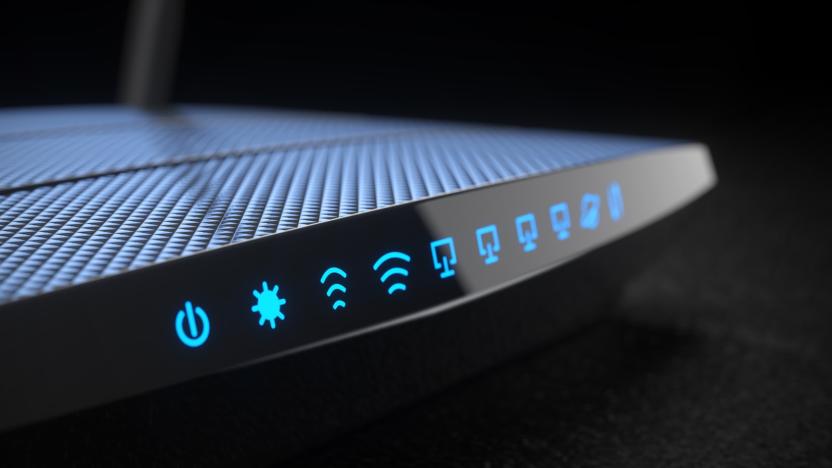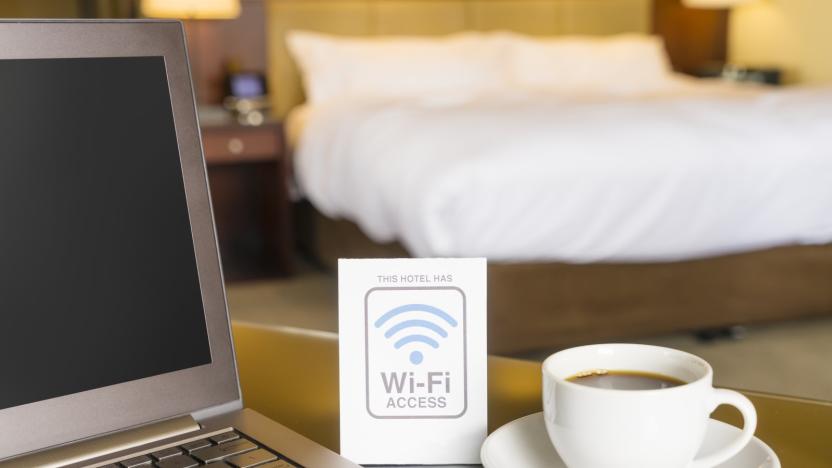WiFiAlliance
Latest

The next generation of wireless networking will be called WiFi 6
Not all WiFi is created equal, and determining which generation of WiFi technology your devices use can be pretty complicated. Did you know that 802.11n predates 802.11ac, for example? For those that don't, the Wi-Fi Alliance is about to make things easier, introducing the next version of WiFi -- 802.11ax -- simply as "WiFi 6."

WiFi's tougher WPA3 security is ready
WiFi security is finally getting an upgrade after 14 years. The Wi-Fi Alliance has officially launched WPA3, the next-generation standard that promises to tackle many of the vulnerabilities that have persisted in wireless networking. Most notably, it brings individualized data encryption that should protect your data against eavesdropping from within the WiFi network. You'll also get tougher password-based sign-ins through Simultaneous Authentication of Equals, a key establishment protocol that reduces the chances of someone guessing your password -- even if it's lousy.

Mesh WiFi gear from different companies could soon work together
Until now, ensuring full WiFi coverage of your home with a mesh network has typically meant buying multiple routers or access points from one company. But with a new mesh standard coming into play, you'll have more choice in how to build out your network because nodes from different companies will theoretically be compatible with each other. With its EasyMesh program, the WiFi Alliance wants to make sure mesh routers from various manufacturers can speak to each other -- just as it used its WiFi certification to ensure wireless access standards.

Tougher WiFi security will keep you safe at the coffee shop
WiFi security hasn't changed much since WPA2 came to be in 2004, and that's becoming increasingly apparent when public hotspots are frequently risky and glaring exploits are all too common. It's about to get a long-due upgrade, though: the Wi-Fi Alliance plans to roll out a WPA3 standard that addresses a number of weak points. For many, the highlight will be individualized data encryption. Even if you're on an open public network, you won't have to worry quite so much about someone snooping on your data.

WiGig will bring superfast WiFi to devices next year
The WiFi Alliance has finally certified "WiGig," a high-speed, 60 GHz standard otherwise known as 802.11ad. Using beamforming, it can yield speeds of up to 8 Gbps, or nearly 1GB per second from a distance of up to 10 meters. As many as 180 million devices using the standard, like routers, laptops and smartphones will arrive by the end of next year, the group said. It also unveiled the first five certified WiGig products from Intel, Dell and Qualcomm, among others.

New WiFi standard offers more range for less power
The WiFi Alliance has finally approved the eagerly-anticipated 802.11ah WiFi standard and dubbed it "HaLow." Approved devices will operate in the unlicensed 900MHz band, which has double the range of the current 2.4GHz standard, uses less power and provides better wall penetration. The standard is seen as a key for the internet of things and connected home devices, which haven't exactly set the world on fire so far. The problem has been that gadgets like door sensors, connected bulbs and cameras need to have enough power to send data long distances to remote hubs or routers. However, the current WiFi standard doesn't lend itself to long battery life and transmission distances.

WiFi devices will soon talk to each other before they connect
WiFi-equipped gadgets don't really say anything to each other before they connect, which limits what they can do -- you can't use them as Bluetooth-like smart beacons, or quickly find who's sharing photos. All that's going to change soon, though, thanks to the newly unveiled WiFi Aware spec. The technology has devices swapping tiny messages about their services when they detect each other, making it easy to send alerts and connect only to those devices you care about. You could quickly find nearby rivals for a multiplayer game, for example, or get a notification about a sale when you wander by a preferred store. And no, battery life shouldn't take a hit. Although WiFi Aware can run in the background, its use of a common "heartbeat" for the sync process could actually make it more efficient than conventional WiFi.

WiFi Alliance absorbs WiGig, reinforces commitment to 60GHz wireless
Just a little over two months since the WiFi Alliance and the Wireless Gigabit Alliance made their engagement plans known, the two groups are finally in marital bliss. They've long worked together on developing and building the 60GHz wireless standard, but decided it was best to make the partnership official in order to get the most out of their collaboration. Long-term plans include expanding WiGig's capabilities and implementing a baseline interoperability certification program by early 2014. This united effort could point to quite a growth spurt; ABI Research forecasts that there'll be annual shipments of 1.8 billion devices with both WiFi and WiGig support by 2016. Though there are no new product announcements at the moment, it looks like the newly unified WiFi Alliance will have plenty to work on over the coming years.

Live from the Engadget CES Stage: an interview with WiGig's Ali Sadri (update: video embedded)
WiGig has some big news to share last week, when it announced that it would be merging with the WiFi Alliance. We'll be discussing the marriage with the organization's President and Chairman, Ali Sadri, and what it means for the future of both organizations. January 10, 2013 7:00 PM EST Check out our full CES 2013 stage schedule here! Update: video embedded

WiFi and WiGig Alliances become one, work to promote 60GHz wireless
The WiFi Alliance and Wireless Gigabit Alliance have a pretty long history of working together. The two are ringing in the new year by removing the last barrier to their cooperation and officially becoming one organization. By the end of the year the group hopes to have an interoperability program launched for 60GHz wireless under the banner of the new unified WiFi Alliance. The hope is that joining forces will lead to broader compatibility and quicker adoption of of the high speed wireless standard. For now there's no new products to announce, but expect a year full exciting wireless developments. For a few more details and some salient quotes from the involved parties, hit up the PR after the break.

WiFi Alliance certificate teases Tizen flavored Samsung Galaxy S III
Ever wondered what Samsung's flagship Galaxy S III phone might be like, if it ran another OS? Okay, arguably something along those lines is already under way, but if a curious WiFi Alliance certification entry is to be understood, Tizen might have made its way on to the phone already. The hook here is the product name. The GS III also goes by the less snappy moniker of GT-I9300, and it's the appearance of GT-I9300_TIZEN in the certification list that has got chins wagging. Of course, a stamp from the WiFI Alliance means little out here in the real world, where everything is still looking rather Android, but it doesn't hurt to imagine the Koreans experimenting with idea, and it wouldn't be the first time either.

Wi-Fi Alliance announces first Miracast-certified devices, full compatibility with Intel WiDi
Take note, because there's a new standard in realm of wireless video streaming and it's known as Miracast. Since the initial announcement, some very respectable manufacturers have chosen to support the specification, which includes Broadcom, NVIDIA and Texas Instruments. Now the Wi-Fi Alliance has announced the first round of products to be certified for Miracast, and as an extremely welcome bit of news, all Intel WiDi devices are supported by the latest standard. In addition to PCs, you can expect Miracast certification to be blessed upon devices such as smartphones, tablets, set-top boxes and televisions. In the retail setting, all Miracast-certified devices will carry the more generic "WiFi Certified" badge (shown here), which also covers technologies such as WiFi Direct. You'll find the press release after the break, which includes the initial list of products and components that've already earned their credentials, along with statements of support from manufacturers such as LG, Samsung and Sony. Not to be left out, we also reached out to Qualcomm, which confirmed its support for the standard, along with its expectation to offer some of the very first products certified for Miracast. It seems that Apple's AirPlay now has some rather determined competition, indeed.

WiFi alliance begins Tunneled Direct Link Setup certification, hopes to improve media streaming
You can thank the WiFi alliance for a number of things, and soon you can add TDLS to that list. That's Tunneled Direct Link Setup, if you were wondering, and it's a standard for creating direct links between devices. If this sounds familiar, that's understandable, but TDLS has its own tricks, like working in the background of a network to optimize performance, and it can even work over a WiFi Direct connection. For example two compliant devices can measure the signal strength on the network, and determine if a direct link would be better or not. TDLS also allows devices to communicate at the fastest standard available (802.11b / g / n etc.) even if this is superior to that available on the rest of your hardware. As this is a client-based protocol, you won't need to upgrade your access point either. If this hasn't got implications for better media streaming written all over it, we don't know what has. Especially as the certification is available to TVs, tablets, phones, cameras and gaming devices. There's only a handful of test products sporting the official approval at this time, but with names such as Broadcom, Marvell and Realtek in the mix, it shouldn't be long before it starts finding its way into front rooms and pockets proper.

NVIDIA throws support behind Miracast as wireless display standard
TI may have blazed the trail, but today NVIDIA has announced that it'll support Miracast as an integral part of its Tegra mobile platform. If you'll recall, Miracast is a creation of the Wi-Fi Alliance, which aims to create a new standard for wireless displays by way of a reference specification and certification program. There are few concrete details to share at this point, as the Miracast spec has yet to be ratified, but NVIDIA has already engaged a number of manufacturers in an effort to drum up support for the new standard -- think it's reason enough for the WiDi and AirPlay crowds to worry?

WiFi Direct headed for a revamp: simpler integration, better support
We love WiFi Direct, we do, but there's no denying the standard has failed to take the world by storm. The WiFi Alliance is going back to the drawing board and looking to streamline its system of connecting devices. A new Wi-Fi Direct Services task group was formed last month, charged with building new tools for helping apps and devices work together. The plan is to have what amounts to a complete revamp of the WiFi Direct standard within 12 to 18 months. One of the keys will be exposing the feature more directly to end users. Often it hides in the background, but the alliance is working on a way for apps to advertise their capabilities to each other and consumers. Developers have also struggled with poorly defined hooks that often lead to incompatible products. Will 2013 finally be the year that WiFi Direct takes off? Who can say. Considering the break-neck pace our technological world moves at, something better may have come along by the time the WiFi Alliance gets its act together.

WiFi alliance begins hardware testing on Passpoint cell-to-hotspot roaming program
It was over a year ago now that we heard about the WiFi Alliance's intention to certify hotspots and simplify the potential for mobile handovers. Now, it's just announced hardware testing of its WiFi-CERTIFIED Passpoint program, which promises to let phones and mobile devices automatically discover and connect to compatible networks. The specification used is the result of cooperation between service providers and equipment manufacturers, with the aim of creating an industry-wide solution for shared WiFi access and roaming agreements. Already hardware from the likes of Cisco, Intel, MediaTek and Qualcomm has received Passpoint certification, leaving the ball in the court of service providers, once testing is complete.

TI cuts the cables, backs Miracast as wireless video standard for OMAP platform
It wasn't but a few days ago that the Wi-Fi Alliance announced its certification program for the Miracast wireless display specification. Now, TI has thrown its weight behind the technology with the announcement that future versions of its OMAP processor and WiLink connectivity chip will adhere to Miracast standards. As you'll recall, the Miracast certification program has yet to go into effect -- that'll happen later this summer -- which means for the time being, it's still too early to refer to TI's solution as "Wi-Fi Certified Miracast." Nonetheless, the company's already showing its compatible wares this week at Computex, which currently includes the OMAP 4470 / WiLink 7.0 combo. Naturally, TI also intends to ensure Miracast support as part of its upcoming OMAP 5 / WiLink 8.0 platform. As if you needed yet another reason to be excited for that one. To learn more, you'll find the full PR after the break.

Wi-Fi Alliance announces Miracast wireless display certification program
The ability to transmit audio-visual content over WiFi is poised to launch a bit of a cable-free revolution in the living room, but before that happens, the Wi-Fi Alliance hopes that manufacturers will rally behind its standard set of technologies known as Miracast -- in the process, burying WiDi and giving AirPlay a run for its money. While the certification program itself has yet to be finalized, it's said to launch later this year and will bless all compatible devices with the "Wi-Fi Certified Miracast" mark. Everything from televisions and set-top boxes, to notebooks, smartphones and tablets will be eligible for certification, which means that we may begin to see the seal in a hell of a lot more places. The PR itself provides scant additional details, but if you're so inclined, feel free to hop the break.

WiFi certification fuels speculation of Samsung Galaxy Note successor (updated)
The Samsung Galaxy Note is just now working its way to the States, but a recent certification by the WiFi Alliance is already stoking the flames of its replacement. Known only as the GT-N8000, it's thought this device may be the eventual replacement for the GT-N7000. Of course, this isn't the only plausible explanation, as the new model number may hint at yet another new family of devices. There's credence to this flow of logic, too, as the Galaxy S II (i9100) was the spiritual decedent of the original Galaxy S (i9000). Whether your preferred method of divination involves tea leaves, crystal balls or Cleverbot, one thing is certain about this new Sammy -- it's gonna be 1,000 more, y'all. Update: Apologies for the crossed wires, as we reported last night, the Samsung GT-N8013 also recently hit the FCC, and is presumably a variation of the GT-N8000.

WiFi Direct and DLNA get friendly, make streaming media a little bit easier
DLNA and WiFi Direct are both pretty sweet technologies on their own but, together, they offer the promise of simple, wireless media streaming without the need for that pesky router middleman. The Digital Living Network Alliance has officially incorporated WiFi Direct into its interoperability guidelines, which means you could soon be streaming movies and music between devices (like your laptop and smartphone) without connecting to a home (or public) network. And don't forget, only one part of the equation needs to be WiFi Direct certified -- so don't worry that your aging computer doesn't support it, as long as your smartphone does you're golden. Check out the PR after the break.








